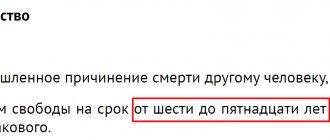Kidnapping is a socially dangerous offense, liability for which is established by Article 126 of the Criminal Code of the Russian Federation.
This type of crime covers several objects, creates a threat to human life and health, and involves the commission of only a specifically established set of actions to initiate a case. In addition, when a person is kidnapped, the Criminal Code of the Russian Federation establishes a number of additional qualifying features that aggravate the situation. Multi-channel free hotline Legal advice on criminal law. Every day from 9.00 to 21.00
Moscow and region: +7 (495) 662-44-36
St. Petersburg: +7 (812) 449-43-40
What is kidnapping?
The article of the criminal law defines the abduction as the actions of the attacker, which are aimed at restricting the freedom of the victim. It should be understood that kidnapping (Article 126 of the Criminal Code of the Russian Federation) is carried out exclusively through the commission of a combination of various criminal manipulations. This atrocity in question differs from other types of similar acts.
The main feature of such a crime is forcing the person who has become the victim to follow the criminal.
In addition to the fact that there was no expression of the victim’s will to leave with the criminal, it should also be understood that the methods of such retention may be different.
Russian and foreign legislation suggests several options for implementing such a crime:
- a secret attempt to steal a person, regardless of what actions should be committed with him next (murder, violence, trafficking, forced labor, staging, like in a movie, etc.);
- a planned attempt to kidnap a person by complicity, conspiracy and group formation (which constitutes an aggravating factor for qualification);
- demonstration of actions on the part of the kidnapper, i.e. open implementation of the crime;
- misleading a person, allowing the victim to be stolen without attracting attention.
The goal will not play a role in this case: whether the criminal wants money, or is it a desire for revenge, or attempts to have fun, as shown in films, and so on.
The resolution of the Plenum of the Armed Forces of the Russian Federation, as well as the history of the development of the nature of the encroachment in question, also reflects the insignificance of motives and goals, only if we are not talking about qualified personnel established by Art. 126 part 2 of the Criminal Code of the Russian Federation. The objective side of the crime must be actually executed in order to be able to send a statement and accept the report of the act as a basis for initiating a criminal case.
It should also be noted that the disposition of the article does not provide any explanations on how to determine the signs of a crime, how this option will differ from others, or whether the act will have a material or formal composition. In such a case, in order to correctly qualify the actions of an attacker, you should refer to the comments of the article of the criminal law in question.
Regarding the establishment of sanctions for attempting to kidnap a person, it should be remembered that only the Criminal Code of the Russian Federation provides for liability for this type of offense. The Code of Administrative Offenses of the Russian Federation does not provide for coercive measures in such a situation; accordingly, all the actions under consideration are defined as crimes and entail a preliminary investigation, trial, punishment and other legal consequences.
Responsibility
Based on qualifying criteria, the court determines the degree of guilt of the participants and imposes a proportionate punishment.
Punitive measures
According to paragraphs of Article 126, the court may sentence the accused:
- Kidnapping without qualifying criteria - forced labor for up to 5 years or a prison sentence for a similar period.
- Committed by prior conspiracy, with the use of violence, against pregnant women, as well as two or more persons - up to 12 years old.
- By an organized group or causing grievous harm and death of the victim - up to 15 years.
Which category does it belong to?
Part 1 of Article 126 falls under the classification of a serious crime, parts 2 and 3 are considered especially serious.
Legal practice
Let's look at a few examples.
The criminal with two accomplices comes to the victim’s home, where, together with his accomplices, he captures the victim, pushes him into the trunk of a car and takes him to the nearest forest. Here, the attackers hold the victim, demanding that they hand over a flash drive with important information. When the condition was met, the victim was released.
The case was considered by the military court of the North Caucasus Military District, where the main accused, a certain K, was serving under a contract. The court found K guilty of kidnapping as part of a group of persons by prior conspiracy, imposing a sentence of 5 years in prison.
Later, at the request of the defense, the punishment was reduced to 3.9 years in prison, taking into account mitigating circumstances.
Objective signs
Criminal liability arises only when an appropriate basis for this is established. This is recognized as a corpus delicti, which will necessarily include both objective and subjective signs of a criminal offense, indicated directly in the article of the special part of the Criminal Code of the Russian Federation and comments to them.
To apply coercive measures to a person and bring him to justice, the presence of four elements is required. The absence of one of them will make it impossible to initiate a criminal case.
The first group of elements for establishing the composition is objective in nature. This category determines how the crime manifests itself and what it encroaches on. Therefore, we should consider the objective side - the manifestation of crime in the external environment and the object. The latter includes human freedom, which is limited by the attacker, and in some cases, an additional object such as honor, dignity, health and life of the victim is highlighted.
The objective side is characterized by active actions that have three variants of expression:
- Seizure. This means directly committing actions that make it possible to kidnap a person, be it secret or open events. The point is that a person is forced to leave his usual environment, most often his place of residence. All this is done through coercion, threats, pressure and other methods of intimidation.
- Moving. This action will be expressed in the transportation of the person to the place of detention. You can use any means of transportation (car, motorcycle, watercraft, etc.). In this case, the moment of movement must be real. If they try to hide a person somewhere, illegally detaining a person, then this will not be kidnapping, but rather deprivation of liberty. In addition, it should be remembered that any movement is considered as an abduction, for example, a person was taken to another locality, country, republic and held there. The qualification in question will also apply here.
- Hold. It involves placing a person in an unusual environment and preventing any movement of the person, excluding the possibility of leaving the place of confinement. The characteristics of such actions may vary. It is possible to force a person to stay in the right place through various “techniques”: intimidation, violence, causing harm to health, etc.
As soon as the above actions begin to be implemented, the crime will be considered completed, and this, in turn, will mean that the type of crime in question is formal and does not require the occurrence of negative consequences to initiate proceedings in the case.
Bibliography
- Kornakova S.V. Logical foundations of criminal procedural evidence. Irkutsk: Publishing house BGUEP, 2009
- Pinkevich T.V. The subjective side of crime: A textbook. - Stavropol. SFMOSU, 2007
- Dvorkin A.I., Samoilov Yu.M., Isaenko V.N., Rizaev A.Sh. Investigation of kidnapping / A.I. Dvorkin, Yu.M. Samoilov, V.N. Isaenko, A.Sh. Rizaev. M. 2013
- Shkhagapsoev Z.L. Some issues of criminalistic characteristics of kidnapping in the North Caucasus region / Z.L. Shkhagapsoev // Society and law. 2012. No. 1
- Ivanov D.L. Study of the problem of kidnapping / D.L. Ivanov // Psychopedagogy in law enforcement agencies. 2014. No. 3
- Kadnikov N.G. (ed.) Criminal law of Russia. General and Special parts. M: Bukva, 2014
Subjective signs
The second category of elements that are necessarily used when establishing the basis for initiating a case is subjective in nature. Here attention is paid to who commits the crime, what characteristics the person has and why this is committed, i.e. the subjective side of the issue is assessed - guilt.
The subject of the crime in question is defined as general, but with a decrease in age indicators.
In order for a person to act as a suspect in a kidnapping case, the person must meet the following characteristics:
- the age of the accused must be at least fourteen years old, since due to the increased severity of the act, this criterion has been reduced from sixteen years to the minimum limit;
- sanity, which requires the offender to be fully aware of what is being done and what the resulting consequences may be.
According to criminal law, a legal entity can never be the subject of a crime.
The subjective side, characterized by guilt, that is, a person’s mental and psychological attitude to the assault, involves a division into types:
- Intent. Here the person will look at events with full awareness of what is happening, anticipation of negative consequences and the desire for them to occur. Moreover, the criminal, with intent, strives to achieve the completion of the act, which will involve causing harm to certain social relations.
- Carelessness. Here the person also controls his own actions, but either does not foresee or does not prevent the possible consequences of the attack, although due to the circumstances he should have done so.
Abduction is carried out only with direct intent, that is, for the specific purpose of detaining a person and limiting his freedom.
Separately, it should be said about the optional signs of the subjective side of such an offense. These include motives and goals.
As a general rule, to establish the composition in question, the determination of such criteria is not necessary, however, statistics and judicial practice show that the majority of kidnappings were committed for mercenary motives, that is, there was always a desire to obtain money, property, even tax breaks, the abolition of obligations to pay debts (pressure on authorized person: inspector, bailiff), etc.
Kidnapping: the concept and essence of the crime
According to the traditional normative explanation, the abduction of a person means a deliberate unlawful act of taking possession or capturing him through open, secret or deceptive manipulation, moving him from his permanent location and keeping him in another place against the will of the person himself. The essence of such actions is to deprive the victim of his freedom, which, in turn, is often associated with the selfish, hooligan motives of the attacker, sometimes with motives of jealousy or revenge.
In most cases, the purpose of the crime is to obtain material benefits for returning the victim to his permanent location. One of the most common cases of human theft is the abduction of a child followed by a ransom demand from his parents. Extortion of a ransom from a family also occurs in cases of theft of adults, in particular when a person is associated with a business - criminals who are aware of this in advance, as a rule, demand huge sums for his release. Less often, the crime involves the attacker’s goal to force his victim to live with him permanently out of jealousy and revenge on another person.
How does kidnapping differ from unlawful imprisonment and hostage taking?
The main factor that distinguishes kidnapping from such acts as unlawful imprisonment and hostage taking is the method of its implementation.
When kidnapping occurs, a person is captured and illegally moved against his will, while illegal deprivation of liberty (Article 127 of the Criminal Code of the Russian Federation) involves only limiting the actions of the victim without deliberate removal from his permanent place of residence. In turn, hostage-taking (Article 206 of the Criminal Code of the Russian Federation) is a forcible detention in a situational place and control over their actions in order to force citizens, organizations and even government bodies to fulfill certain conditions set by the captors for the release of citizens. When citizens are kidnapped, the demand for ransom and fulfillment of other conditions is implemented in secret.







